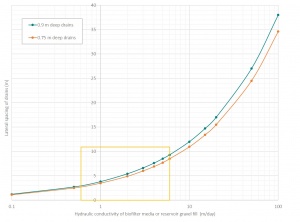Groundwater
The target separation between the base of an exfiltrating LID practice and the water table is 0.9 m.
This is to mitigate risks due to short periods of groundwater mounding and potentially unobserved seasonal fluctuations. In areas where a 0.9 m separation cannot be provided, or where conditions dictate that an even greater separation may be warranted, additional discussion and/or analysis specific to the physical characteristics of the site and the proposed design should be completed. The design practitioner is advised to consult with approval agencies to understand their requirements and/or expectations prior to undertaking work, and to complete an appropriate level of analysis to support their conclusion. The requirement for additional investigation and/or documentation supporting a proposed design may be reduced in areas where ≥ 0.9 m separation is anticipated.
Retention of an unsaturated zone beneath the practice :
- Minimizes the potential for functional impacts associated with reduced percolation rates,
- Maintains the physical and biochemical water quality treatment benefits provided within the vadose zone.
Groundwater mounding[edit]
Groundwater mounding describes the localised raising of the water table beneath infiltration practices. It may be of concern if it affects nearby structures including building foundations. When you wish to model the extent of groundwater mounding beneath an infiltration facility. This tool uses Hantush's derivation (1967).
Note that this is a minor adaptation (metric units and formatting) from the original tool, written and hosted by the USGS.
Reducing groundwater mounding with underdrains[edit]
Mounding of groundwater can be mitigated by correctly sizing and spacing of the pipes within the underdrain structure. In most large infiltrating LID systems (e.g. Bioretention, permeable paving or dry ponds, lateral drains should be spaced between 5 - 6 m apart. But when groundwater mounding must be minimized, this distance will be reduced and should be recalculated.
This recommendation is supported by an analysis of Hooghoudt's equation [1][2][3] in relation to loamy or clayey native soils, where Kmedia>>Ksoil, finds the first term of the numerator negligible, so that the original equation: may be simplified to:
Where:
- Kmedia is expressed in m/day
- Dd is the depth to the drain pipe (m)
- Dw is the minimum acceptable depth to the water table during infiltration event
- q is the inflow volume expressed as a depth over the entire surface (m)
Preventing groundwater interaction[edit]
Many LID systems rely upon reuse, or evaporation and transpiration instead of infiltration to the ground. If the site cannot support any infiltration, consider
Sources of groundwater data[edit]
- ↑ H.P.Ritzema, 1994, Subsurface flow to drains. Chapter 8 in: H.P.Ritzema (ed.), Drainage Principles and Applications, Publ. 16, pp. 236-304, International Institute for Land Reclamation and Improvement (ILRI), Wageningen, The Netherlands. ISBN 90-70754-33-9
- ↑ W.H. van der Molen en J.Wesseling, 1991. A solution in closed form and a series solution to replace the tables for the thickness of the equivalent layer in Hooghoudt's drain spacing equation. Agricultural Water Management 19, pp.1-16
- ↑ van Beers, W.F.J. 1976, COMPUTING DRAIN SPACINGS: A generalized method with special reference to sensitivity analysis and geo-hydrological investigations, International Institute for Land Reclamation and Improvement (ILRI) Wageningen, The Netherlands


